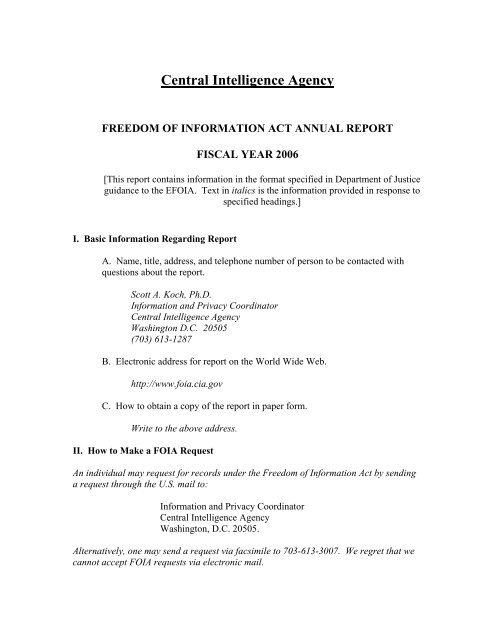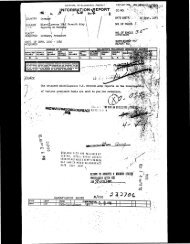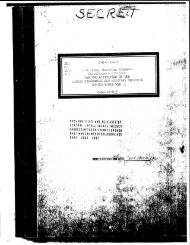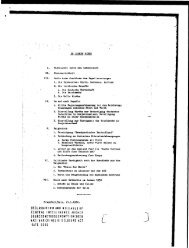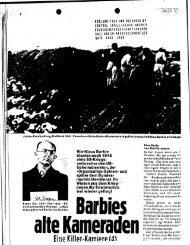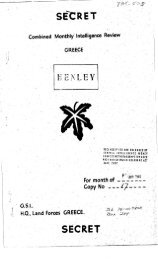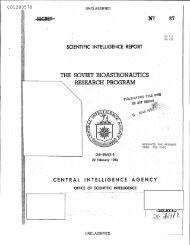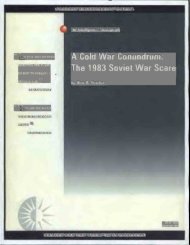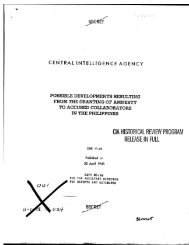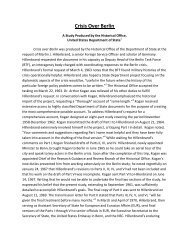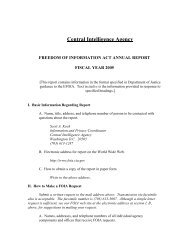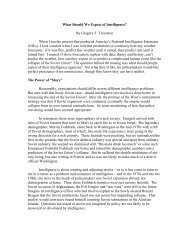PDF - CIA FOIA - Central Intelligence Agency
PDF - CIA FOIA - Central Intelligence Agency
PDF - CIA FOIA - Central Intelligence Agency
You also want an ePaper? Increase the reach of your titles
YUMPU automatically turns print PDFs into web optimized ePapers that Google loves.
<strong>Central</strong> <strong>Intelligence</strong> <strong>Agency</strong><br />
FREEDOM OF INFORMATION ACT ANNUAL REPORT<br />
FISCAL YEAR 2006<br />
[This report contains information in the format specified in Department of Justice<br />
guidance to the E<strong>FOIA</strong>. Text in italics is the information provided in response to<br />
specified headings.]<br />
I. Basic Information Regarding Report<br />
A. Name, title, address, and telephone number of person to be contacted with<br />
questions about the report.<br />
Scott A. Koch, Ph.D.<br />
Information and Privacy Coordinator<br />
<strong>Central</strong> <strong>Intelligence</strong> <strong>Agency</strong><br />
Washington D.C. 20505<br />
(703) 613-1287<br />
B. Electronic address for report on the World Wide Web.<br />
http://www.foia.cia.gov<br />
C. How to obtain a copy of the report in paper form.<br />
Write to the above address.<br />
II. How to Make a <strong>FOIA</strong> Request<br />
An individual may request for records under the Freedom of Information Act by sending<br />
a request through the U.S. mail to:<br />
Information and Privacy Coordinator<br />
<strong>Central</strong> <strong>Intelligence</strong> <strong>Agency</strong><br />
Washington, D.C. 20505.<br />
Alternatively, one may send a request via facsimile to 703-613-3007. We regret that we<br />
cannot accept <strong>FOIA</strong> requests via electronic mail.
A. Names, addresses, and telephone numbers of all individual agency<br />
components and offices that receive <strong>FOIA</strong> requests.<br />
The mailing address in section I.A. above is the proper office within <strong>CIA</strong><br />
to receive <strong>FOIA</strong> requests. Any <strong>CIA</strong> component receiving what purports to be a<br />
request for information under the <strong>FOIA</strong> will forward that request to the address<br />
listed in section I.A., above.<br />
B. Brief description of the agency’s response-time ranges.<br />
For those <strong>FOIA</strong> cases closed in FY 2006, 80% were closed in 156 days;<br />
median response time was 43 days; average response time was 201 days.<br />
For those Privacy Act cases closed in FY 2006, 80% were closed in 45<br />
days; median response time was 20 days; average response time was 53 days.<br />
C. Brief description of why some requests are not granted.<br />
<strong>CIA</strong> consistently protects, among other things, classified national security<br />
information, information relating to intelligence sources and methods, and<br />
organizational information from release under the <strong>FOIA</strong> and takes full advantage of all<br />
of the <strong>FOIA</strong>’s exemptions.<br />
III. Definitions of Terms and Acronyms Used in the Report<br />
A. <strong>Agency</strong>-specific acronyms or other terms.<br />
None.<br />
B. Basic terms, expressed in common terminology.<br />
1. <strong>FOIA</strong>/PA Request – Freedom of Information Act/Privacy Act request.<br />
A <strong>FOIA</strong> request generally is a request for access to records concerning a third party, an<br />
organization, or a particular topic of interest. A Privacy Act request is a request for<br />
records concerning oneself; such requests are also treated as <strong>FOIA</strong> requests. (All<br />
requests for access to records, regardless of which law is cited by the requester, are<br />
included in this report.)<br />
2. Initial Request – a request to a federal agency for access to records<br />
under the Freedom of Information Act.<br />
3. Appeal – a request to a federal agency asking that it review at a higher<br />
administrative level a full denial or partial denial of access to records under the Freedom<br />
of Information Act, or any other <strong>FOIA</strong> determination such as a matter pertaining to fees.
4. Processed Request or Appeal – a request or appeal for which an agency<br />
has taken a final action on the request or the appeal in all respects.<br />
5. Multi-track Processing – a system in which simple requests requiring<br />
relatively minimal review are placed in one processing track and more voluminous and<br />
complex requests are placed in one or more other tracks. Requests in each track are<br />
processed on a first-in/first-out basis. A requester who has an urgent need for records<br />
may request expedited processing (see below).<br />
6. Expedited Processing – an agency will process a <strong>FOIA</strong> request on an<br />
expedited basis when a requester has shown an exceptional need or urgency for the<br />
records which warrants prioritization of his or her request over other requests that were<br />
made earlier.<br />
7. Simple Request – a <strong>FOIA</strong> request that an agency using multi-track<br />
processing places in its fastest (non-expedited) track based on the volume and/or<br />
simplicity of records requested.<br />
8. Complex Request – a <strong>FOIA</strong> request that an agency using multi-track<br />
processing places in a slower track based on the volume and/or complexity of records<br />
requested.<br />
9. Grant – an agency decision to disclose all records in full in response to<br />
a <strong>FOIA</strong> request.<br />
10. Partial Grant – an agency decision to disclose a record in part in<br />
response to a <strong>FOIA</strong> request, deleting information determined to be exempt under one or<br />
more of the <strong>FOIA</strong> exemptions; or a decision to disclose some records in their entireties,<br />
but to withhold others in whole or in part.<br />
11. Denial – an agency decision not to release any part of a record or<br />
records in response to a <strong>FOIA</strong> request because all the information in the requested<br />
records is determined by the agency to be exempt under one or more of the <strong>FOIA</strong>’s<br />
exemptions, or for some procedural reason (such as because no record is located in<br />
response to an <strong>FOIA</strong> request).<br />
12. Time Limits – the time period in the Freedom of Information Act for<br />
an agency to respond to a <strong>FOIA</strong> request (ordinarily, 20 working days from proper receipt<br />
of a “perfected” <strong>FOIA</strong> request).<br />
13. “Perfected” Request – a <strong>FOIA</strong> request for records which adequately<br />
describes the records sought, which has been received by the <strong>FOIA</strong> office of the agency<br />
or agency component in possession of the records, and for which there is no remaining<br />
question about the payment of applicable fees.
14. Exemption 3 Statute – a separate federal statute prohibiting the<br />
disclosure of a certain type of information and authorizing its withholding under <strong>FOIA</strong><br />
subsection (b)(3).<br />
15. Median Number – the middle, not average, number. For example, of<br />
3, 7, and 14, the median number is 7.<br />
16. Average Number – the number obtained by dividing the sum of a<br />
group of numbers by the quantity of numbers in the group. For example, of 3, 7, and 14,<br />
the average number is 8.<br />
IV. Exemption 3 Statutes<br />
List of Exemption 3 Statutes relied on by agency during current fiscal year.<br />
(1) The <strong>Central</strong> <strong>Intelligence</strong> <strong>Agency</strong> Act of 1949, as amended, codified at 50<br />
U.S.C. § 403g.<br />
(2) Statute: 26 U.S.C. § 6103<br />
1. Brief description of type(s) of information withheld under each statute.<br />
Among other things, the <strong>Central</strong> <strong>Intelligence</strong> <strong>Agency</strong> Act of 1949<br />
authorizes the <strong>Agency</strong> to protect <strong>CIA</strong> budget information from disclosure<br />
and information relating to the organization, functions, names, official<br />
titles, salaries, or numbers of personnel employed by the <strong>CIA</strong>, including<br />
information relating to intelligence sources and methods.<br />
26 U.S.C. 6103 prohibits the disclosure of tax returns and return<br />
information.<br />
2. Statement of whether a court has upheld the use of each statute. If so,<br />
cite example.<br />
Yes, See, e.g.,<br />
Halperin v. <strong>CIA</strong>, 629 F.2d 144 (D.C. Cir. 1980) (section 6, <strong>CIA</strong> Act of<br />
1949).<br />
Minier v. <strong>CIA</strong>, 88 F.3d 796 (9 th Cir. 1996) - section 6, <strong>CIA</strong> Act of 1949.<br />
Church of Scientology v. IRS, 484 U.S. 9 (1987)<br />
See “U.S. Department of Justice Freedom of Information Act Guide and Privacy<br />
Act Overview” for additional examples of (b)(3) statutes available to the <strong>CIA</strong> and<br />
applicable case law.
V. Initial <strong>FOIA</strong>/PA Access Requests<br />
A. Numbers of initial requests.<br />
1. Requests pending as of end of preceding year: 975<br />
2. Requests received during current fiscal year: 2500<br />
3. Requests processed during current fiscal year: 2579<br />
4. Requests pending as of end of current fiscal year: 896<br />
B. Disposition of initial requests.<br />
1. Number of total grants: 267<br />
2. Number of partial grants: 939<br />
3. Number of denials: 495<br />
Number of times each <strong>FOIA</strong> exemption used (counting each<br />
exemption once per request):<br />
(1) Exemption 1: 703<br />
(2) Exemption 2: 93<br />
(3) Exemption 3: 942<br />
(4) Exemption 4: 17<br />
(5) Exemption 5: 83<br />
(6) Exemption 6: 172<br />
(7) Exemption 7(a): 3<br />
(8) Exemption 7(b): 1<br />
(9) Exemption 7(c): 48<br />
(10) Exemption 7(d): 30<br />
(11) Exemption 7(e): 43
(12) Exemption 7(f): 2<br />
(13) Exemption 8: 0<br />
(14) Exemption 9: 0<br />
4. Other reasons for nondisclosure (total): 878<br />
a. no records: 370<br />
b. referrals: 80<br />
c. request withdrawn: 121<br />
d. fee-related reason: 85<br />
e. records not reasonably described: 18<br />
f. not a proper <strong>FOIA</strong> request for some other reason: 79<br />
g. not an agency record: 8<br />
h. duplicate request: 25<br />
i. other: includes cancellations due to lack of requester response<br />
to SPR, death of requester, response material returned undeliverable, administrative<br />
error, early appeal/litigation, etc. 92<br />
VI. Appeals of Initial Denials of <strong>FOIA</strong>/PA Requests<br />
A. Numbers of appeals.<br />
1. Number of appeals received during fiscal year: 166<br />
2. Number of appeals processed during fiscal year: 203<br />
B. Disposition of appeals.<br />
1. Number completely upheld: 115<br />
2. Number partially reversed: 31<br />
3. Number completely reversed: 7<br />
Number of times each <strong>FOIA</strong> exemption used (counting each<br />
exemption once per appeal):
(1) Exemption 1: 124<br />
(2) Exemption 2: 5<br />
(3) Exemption 3: 136<br />
(4) Exemption 4: 1<br />
(5) Exemption 5: 5<br />
(6) Exemption 6: 14<br />
(7) Exemption 7(a): 0<br />
(8) Exemption 7(b): 0<br />
(9) Exemption 7(c): 1<br />
(10) Exemption 7(d): 2<br />
(11) Exemption 7(e): 2<br />
(12) Exemption 7(f): 0<br />
(13) Exemption 8: 0<br />
(14) Exemption 9: 0<br />
4. Other reasons for nondisclosure (total): 50<br />
a. no records: 38<br />
b. referrals: 2<br />
c. request withdrawn: 2<br />
d. fee-related reason: 1<br />
e. records not reasonably described: 0<br />
f. not a proper <strong>FOIA</strong> request for some other reason: 1<br />
g. not an agency record: 0<br />
h. duplicate request: 1
early litigation 5<br />
i. other: includes cancellations due to administrative error and<br />
VII. Compliance With Time Limits/Status of Pending Requests<br />
A. Median processing time for requests processed during the year.<br />
1. Simple requests.<br />
a. number of requests processed: 395<br />
b. median number of days to process: 7<br />
2. Complex request.<br />
a. number of requests processed: 2,184<br />
b. median number of days to process: 59<br />
3. Requests accorded expedited processing.<br />
a. number of requests processed: 0<br />
b. median number of days to process: Not applicable<br />
B. Status of pending requests.<br />
1. Requests pending as of end of current fiscal year: 896<br />
2. Median number of days that such requests were pending as of that date:<br />
<strong>FOIA</strong> - 234; PA -74<br />
VIII. Comparisons With Previous Year(s)<br />
A. Comparison of number of requests received:<br />
2,500 in FY06 vs. 2,935 in FY05 vs. 3,055 in FY04 vs. 3,136 in FY03<br />
B. Comparison of number of requests processed:<br />
2,579 in FY06 vs. 3,110 in FY05 vs. 3,336 in FY04 vs. 3,252 in FY03<br />
C. Comparison of median numbers of days requests were pending as of end of<br />
fiscal year:
<strong>FOIA</strong> – 234 in FY 06 vs. 324 in FY05 vs. 349 in FY04 vs. 480 in FY03<br />
PA – 74 in FY 06 vs. 99 in FY05 vs. 127 in FY04 vs. 221 in FY03<br />
D. Other statistics significant to agency:<br />
40 requests for expedited processing received in FY06, 0 requests granted<br />
53 requests for expedited processing received in FY05, 0 requests granted<br />
18 requests for expedited processing received in FY04, 1 request granted<br />
No statistics available for FY03<br />
IX. Costs/<strong>FOIA</strong> Staffing<br />
X. Fees<br />
A. Staffing levels.<br />
1. Number of full-time <strong>FOIA</strong> personnel: 38<br />
2. Personnel with part-time or occasional <strong>FOIA</strong> duties (FTE): 36.5<br />
3. Total estimated number of personnel (FTE): 74.5<br />
B. Total estimated costs (including staff and all resources).<br />
1. <strong>FOIA</strong> processing (including appeals): $8.87 million<br />
2. Litigation-related activities: $1.19 million<br />
3. Total estimated costs: $10.06 million<br />
C. Statement of additional resources needed for <strong>FOIA</strong> compliance (optional)<br />
A. Total amount of fees collected by agency for processing requests: $4732.80<br />
B. Percentage of total costs: less than 1%<br />
XI. <strong>FOIA</strong> Regulations (Including Fee Schedule)<br />
<strong>CIA</strong> <strong>FOIA</strong> and Privacy Act regulations are codified at 32 CFR Parts 1900 and<br />
1901, respectively, and can be obtained by contacting the Information and Privacy<br />
Coordinator (see Sec. I of this report); by referencing the Federal Register / Vol. 62, No.<br />
115 / Monday, June 16, 1997 (available at public libraries); or by accessing the Internet<br />
at http.www.foia.cia.gov - - click on “Your Rights/Freedom of Information Act/Your<br />
Rights <strong>FOIA</strong> /Code of Federal Regulations….”
XII. Report on <strong>FOIA</strong> Executive Order Implementation<br />
A. Description of supplementation/modification of agency improvement plan (if<br />
applicable)<br />
<strong>CIA</strong> has not modified its improvement plan.<br />
B. Report on agency implementation of its plan, including its performance in meeting<br />
milestones, with respect to each improvement area.<br />
• Overall website improvement.<br />
We have added links to the <strong>FOIA</strong> programs of other government agencies with<br />
which we have close working relationship, including the Department of State,<br />
Department of Justice, Department of Defense, National Security <strong>Agency</strong>, National<br />
Reconnaissance Office, and the National Archives and Records Administration. We have<br />
also added a section of “frequently asked questions,” so that requester can find answers to<br />
common questions in one place rather than have to navigate our website.<br />
• Proactive disclosure of information.<br />
We are current in putting material on our public website. At the beginning of<br />
Fiscal Year 2006 we were approximately two years behind in posting documents on our<br />
web site; it now takes us only one month and we have adopted that as our standard.<br />
• Tracking the progress of cases.<br />
We have improved our ability to track the progress of cases internally as the<br />
documents in them undergo multi-directorate review. Case managers now can better<br />
coordinate the cases among the directorate information review offices through regular<br />
“tickler” notes or requests for case status, which promises to reduce response time. Case<br />
managers now produce regular reports so that management can identify cases that may<br />
require intervention to solve unique problems or unexpected delays.<br />
• Reducing the backlog of old cases (five or more years old).<br />
Although we set as a goal reducing the backlog of our oldest and most difficult<br />
cases 25 percent by 31 October 2006, we put particular emphasis on dealing with these<br />
cases and were able to substantially exceed this goal—reducing the number of cases five<br />
or more years old by 40 percent.<br />
C. Identification and discussion of any deficiency in meeting plan milestones (if<br />
applicable).
• The current state of <strong>CIA</strong>’s automated electronic <strong>FOIA</strong> tracking and<br />
documentation system.<br />
<strong>CIA</strong> has not been able to deploy the <strong>CIA</strong> Automated Declassification and Release<br />
Environment (CADRE) system to the <strong>FOIA</strong> case managers by 31 December 2006. We<br />
have been doing extensive user acceptance testing to ensure the system meets all of the<br />
work flow process and quality assurance requirements the <strong>FOIA</strong> case managers have.<br />
We have also thoroughly and exhaustively been checking all the data before migrating it<br />
from the old to the new system to make certain that the information CADRE will contain<br />
is complete and accurate. Barring unforeseen difficulties, we anticipate that CADRE will<br />
be operational and available for <strong>FOIA</strong> case managers by the third quarter of calendar year<br />
2007.<br />
• Reducing the overall backlog of outstanding cases.<br />
For the ninth consecutive year, <strong>CIA</strong> has reduced its overall backlog of<br />
outstanding <strong>FOIA</strong> cases. In Fiscal Year 2006, we reduced the overall backlog by 8<br />
percent, which is slightly shy of our goal of 10 percent.<br />
We had become concerned, not just about the overall backlog, but about the<br />
number of difficult cases we had that were five or more years old. We were determined<br />
to address this issue and make it a priority, and so devoted some of the finite resources<br />
we would normally use on overall backlog reduction to target our oldest cases.<br />
Reducing the backlog of our oldest cases by 25 percent is our priority for Fiscal<br />
Year 2007. We will reallocate the resources devoted to this goal only if we reach it<br />
before 1 October 2007. In that event, we will use these resources to assist in reducing the<br />
overall backlog 10 percent by 1 October 2007.<br />
• Forms of communication with requesters.<br />
We have made significant progress in improving, both in terms of clarity and<br />
brevity, the thousands of correspondence templates we use while retaining necessary<br />
legal language. We have not finished this task due to the sheer volume of templates. We<br />
are, however, revising them as we find we need to use them in specific situations and will<br />
have completed all of them by February 2008.<br />
We have made a concerted effort to improve our personal interaction with<br />
requesters. We encourage case managers to call requesters if they can help narrow the<br />
scope of a request or determine what the requester actually wants. We have found that a<br />
modest investment in time at the beginning pays big dividends in more focused requests<br />
that result in the release of responsive documents.<br />
Our <strong>FOIA</strong> Requester Service Center is fully operational, and we have appointed<br />
two <strong>FOIA</strong> Public Liaison officers. Our website tells requesters how to reach the Liaison<br />
officers, and this information is also available through our <strong>FOIA</strong> hotline, where<br />
requesters can get information about the status of their cases.
D. Additional narrative statement regarding other executive order-related activities<br />
(optional).<br />
Nothing to report.<br />
E. Concise descriptions of <strong>FOIA</strong> exemptions.<br />
• (b)(1) exempts from disclosure information properly classified, pursuant to an<br />
Executive Order;<br />
• (b)(2) exempts from disclosure information, which pertains solely to the internal<br />
personnel rules and practices of the <strong>Agency</strong>;<br />
• (b)(3) exempts from disclosure information that another federal statute protects,<br />
provided that the other federal statute either requires that the matters be withheld,<br />
or establishes particular criteria for withholding or refers to particular types of<br />
matters to be withheld. The (b)(3) statutes upon which the <strong>CIA</strong> relies include, but<br />
are not limited to, the <strong>CIA</strong> Act of 1949;<br />
• (b)(4) exempts from disclosure information such as trade secrets and commercial<br />
or financial information that is obtained from a person and that is privileged or<br />
confidential;<br />
• (b)(5) exempts from disclosure inter-and intra-agency memoranda or letters that<br />
would not be available by law to a party other than an agency in litigation with the<br />
agency (i.e., information to which any privilege recognized by the federal courts<br />
applies, including information protected by the deliberative process privilege, the<br />
attorney-client privilege, and the attorney work-product privilege) ;<br />
• (b)(6) exempts from disclosure information from personnel and medical files and<br />
similar files the disclosure of which would constitute a clearly unwarranted<br />
invasion of privacy;<br />
• (b)(7) exempts from disclosure information compiled for law enforcement<br />
purposes to the extent that the production of the information (A) could reasonably<br />
be expected to interfere with enforcement proceedings; (B) would deprive a<br />
person of a right to a fair trial or an impartial adjudication; (C) could reasonably<br />
be expected to constitute an unwarranted invasion of personal privacy; (D) could<br />
reasonably be expected to disclose the identity of a confidential source or, in the<br />
case of information compiled by a criminal law enforcement authority in the<br />
course of a criminal investigation or by an agency conducting a lawful national<br />
security intelligence investigation, information furnished by a confidential source;<br />
(E) would disclose techniques and procedures for law enforcement investigations<br />
or prosecutions if such disclosure could reasonably be expected to risk<br />
circumvention of the law; or (F) could reasonably be expected to endanger any<br />
individual’s life or physical safety;<br />
• (b)(8) exempts from disclosure information contained in reports or related to<br />
examination, operating, or condition reports prepared by, or on behalf of, or for
use of an agency responsible for regulating or supervising financial institutions;<br />
and<br />
• (b)(9) exempts from disclosure geological and geophysical information and data,<br />
including maps, concerning wells.<br />
F. Additional statistics:<br />
1. Time range of requests pending, by date of request (or, where applicable, by<br />
date of referral from another agency)<br />
Our pending cases date from February 1992 through 23 January 2007. We have<br />
re-reviewed the oldest case internally to determine if the passage of time warranted a<br />
more liberal release than the first incomplete review indicated. After re-review, we<br />
determined that the case contained the equities of eight other government agencies and in<br />
May 2006 sent it to them. We have not yet received all their responses, but anticipate<br />
closing this request in the first quarter of 2007 because it is our top priority “old case.”<br />
2. Time range of consultations pending with other agencies, by date of initial<br />
interagency communication.<br />
Our outstanding coordinations with other government agencies date from June<br />
2001 through 29 January 2007.<br />
G. Attachment: <strong>Agency</strong> improvement plan (in current form).<br />
Attached.


